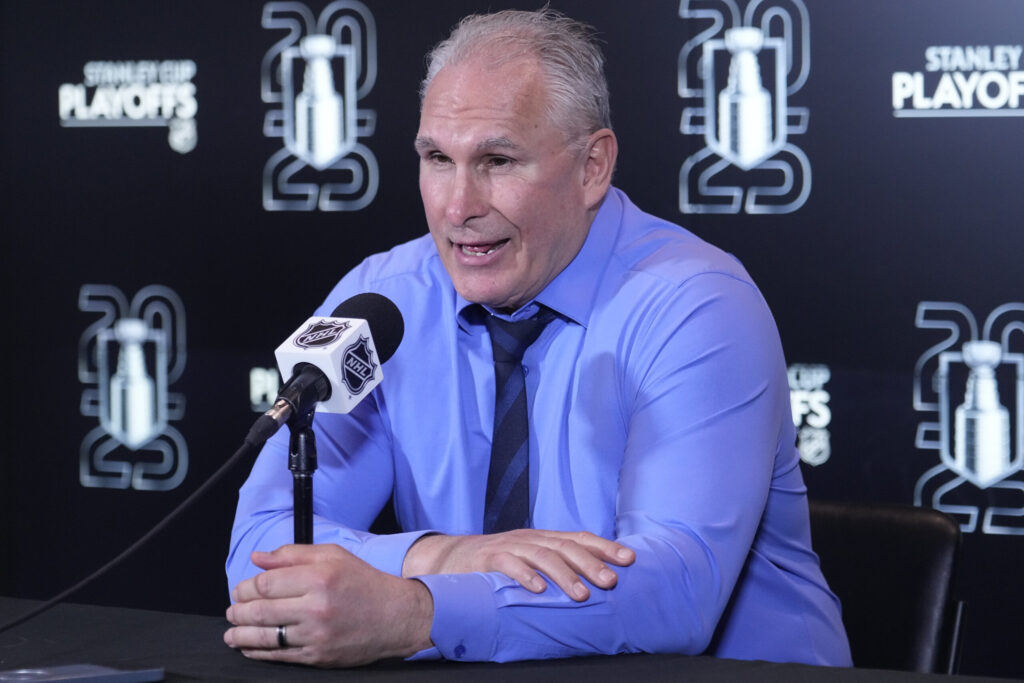The shockwaves from the offseason blockbuster that sent Mitch Marner to Vegas have finally subsided, but the aftershocks are now rumbling through the Maple Leafs’ training camp. For the first time in nearly a decade, the “Core Four” is no more, and a fundamental question hangs heavy over the organization: Who, exactly, is going to play with Auston Matthews?
The departure of a player like Marner doesn’t just leave a hole; it creates a vacuum. It’s a 90-plus point, penalty-killing, power-play quarterbacking vacuum that General Manager Brad Treliving is now tasked with filling. As the new season dawns, it’s become clear that this isn’t a simple plug-and-play problem. The search for Matthews’ new running mate is a complex chess match, constrained by a tight salary cap, a depleted war chest of assets, and the ever-present pressure cooker of the Toronto hockey market.
Also on the EDGE – Can William Nylander Become the Leader the Maple Leafs Need?
The Audition Begins
With free agency in the rearview mirror and no immediate trade on the horizon, Head Coach Craig Berube is turning training camp into an open audition. The mandate is clear: find the right fit from within, at least for now. Two primary candidates have emerged from the pack, each presenting a different blend of potential and risk.
First up is Matias Maccelli, the slick Finnish winger acquired in an offseason deal with the Utah Mammoth. On paper, the move looks like a classic “buy low” gamble by Treliving. Maccelli is just two seasons removed from back-to-back campaigns of 49 and 57 points, showcasing legitimate top-six playmaking skills. However, a dismal 18-point performance last season sent his value plummeting, allowing the Leafs to acquire him as a high-reward reclamation project. He was given the first crack alongside Matthews and Matthew Knies in preseason action, but early returns have been mixed. Observers note that he lacks the explosive dynamism and flash that made the Matthews-Marner connection so lethal. He’s a skilled player, to be sure, but whether his brand of offence can truly mesh with a generational goal-scorer like Matthews remains an open question.


The other leading contender is the perpetually energetic Max Domi. Where Maccelli offers finesse, Domi brings sandpaper and snarl. The appeal is obvious. Treliving has openly stated he’s looking for “a little bit of a different ingredient” for his top six, and Domi’s relentless forechecking and willingness to engage physically certainly fit that description. The vision of Domi creating chaos in the corners, retrieving pucks, and opening up space for Matthews to work his magic is tantalizing. The problem, as has often been the case with Domi, is consistency. A 33-point output in 74 games last season isn’t going to cut it on a top line. While his energy is a known asset, his offensive production can be frustratingly streaky.
The battle between Maccelli and Domi is a fascinating microcosm of the team’s current dilemma: a choice between a skilled player trying to rediscover his game and a high-energy player trying to elevate his. Neither is a perfect replacement for Marner, and for now, the top line feels more like a work in progress than a finished product.
The GM’s Handcuffs
While Berube tinkers with his lines on the ice, Brad Treliving is navigating a far more restrictive game in the front office. His desire to acquire a bona fide top-six forward is being stymied by a trifecta of significant constraints.
First and foremost is the salary cap. The Leafs are currently operating with less than $2 million in cap space, a razor-thin margin that makes adding any player of consequence virtually impossible without shedding salary. This leads directly to the second problem: a handful of burdensome contracts that are difficult to move. While no single deal is catastrophic, the combined weight of contracts for players like David Kampf ($2.4 million AAV), Max Domi ($3.75 million AAV), and Nicholas Robertson ($1.825 million AAV) limits Treliving’s flexibility. Given their inconsistent production relative to their cap hits, rival GMs aren’t exactly lining up to take these deals without a significant “sweetener” attached.
And that’s where the third handcuff appears: a depleted stock of trade assets. Years of “going for it” have left the Leafs’ draft cupboard alarmingly bare. The team does not hold a first-round pick until 2028 and possesses a mere three selections in the entire 2026 NHL Draft. These picks are the currency of the trade market, and Treliving is effectively trying to shop at a luxury goods store with pocket change. Without premium picks to entice a seller, any significant trade would likely require moving a promising young player or a key roster piece, a price the GM seems hesitant to pay—for now.
A New Blueprint for the Blue and White
For all the challenges, Marner’s departure has forced a philosophical shift in roster construction that may prove beneficial in the long run. The “Core Four” era, defined by a top-heavy salary structure, is over. The cap space once allocated to Marner has been redistributed throughout the lineup, allowing Treliving to build something the Leafs haven’t had in years: legitimate forward depth.
The team now boasts a glut of NHL-caliber forwards, effectively erasing the stark line that once existed between a high-powered “Team A” and a replacement-level “Team B.” By adding several prime-aged depth players, Treliving has constructed a roster where contributions can, and must, come from all four lines. This new identity aligns perfectly with the hard-nosed, relentless style of hockey Berube is known for. The goal is no longer to simply outscore opponents with overwhelming top-end talent, but to wear them down with a balanced, four-line attack.

This newfound depth is now a necessity, not a luxury. The offence lost with Marner’s exit must be replaced by committee. The success of this season will depend heavily on the ability of the third and fourth lines to control play, chip in offensively, and provide the kind of lineup balance that has been sorely missing in past playoff failures.
The Waiting Game
As the puck prepares to drop on a new season, the Maple Leafs find themselves in a state of calculated uncertainty. Treliving appears content to let the internal competition for the top-line role play out, giving his internal candidates a chance to seize the opportunity. But make no mistake, the search for an external solution continues.
The consensus around the league is that a trade is not a matter of if, but when. The market for top-six wingers is notoriously tight at the start of the season, but it invariably loosens as the trade deadline approaches. Treliving is playing the long game, waiting for the right player to become available at a price he can afford.
For now, the Leafs will move forward with their revamped, deeper roster, hoping that a combination of internal auditions and a “strength in numbers” approach can carry them through the early part of the schedule. The pressure is on Maccelli and Domi to prove they belong, on the bottom-six to validate the new team-building philosophy, and on Treliving to navigate his tightrope walk with skill and patience. The post-Marner era has begun, defined not by a star replacement, but by a question mark and a GM waiting for the perfect moment to make his move.
Created with the aid of Gemini AI
